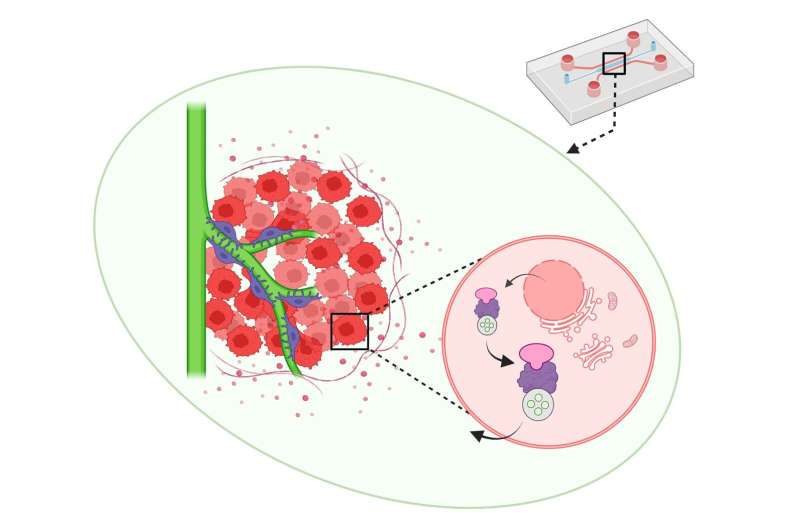
Cancer, the second leading cause of death worldwide, is more likely to respond to effective treatment if identified early before metastasizing, resulting in a greater probability of surviving.
Some rare cancers outsmart human interventions and metastasize before being detected. Alveolar soft-part sarcoma, or ASPS, accounts for only 0.01% of all cancers. Although ASPS grows slowly, it can spread quickly in the body, dodging conventional chemotherapy.
To understand the cancer’s angiogenic—blood vessel growth—mechanism, researchers have relied on models using immunocompromised animals engrafted with patient-derived tumor samples. However, conventional methods restrict researchers with ethical issues and provide no information about molecular mechanisms such as intercellular interactions.
Now, a team of researchers, including Kyoto University, has developed the first ASPS-on-a-chip, which closely mimics the microenvironment during tumor vessel formation. The study is published in the journal Proceedings of the National Academy of Sciences.
“Our microfluidic co-culture vasculature chip should give us insight into the angiogenic mechanism and possible strategies for stopping tumor growth in ASPS patients,” says lead author Surachada Chuaychob of KyotoU’s Department of Micro Engineering (now at KyotoU’s Institute of Advanced Energy).
The team designed this tumor-mimicking chip to reproduce the natural functions of human endothelial cells and pericytes to form blood capillaries in the initial stage of ASPS in vitro.
“We discovered that blood vessels with pericytes, also known as angiogenic sprouts, can be induced with improved results in a 3D spheroid made entirely of ASPS tumor cells on a chip,” says team leader Ryuji Yokokawa at KyotoU’s Department of Micro Engineering.
“The in vitro model demonstrates the cell-to-cell interactions leading to ASPS angiogenesis, which confirms previous in vivo results,” explains co-author Takuro Nakamura at Tokyo Medical University.
“Our study is also crucial in highlighting the critical roles of Rab27a and Sytl2 proteins in intracellular trafficking and verifying cell-to-cell interactions in ASPS angiogenesis,” adds Miwa Tanaka at the Japan Foundation for Cancer Research.
Yokokawa’s team anticipates applying their ASPS-on-a-chip model as a screening tool for developing new drugs by suppressing intracellular trafficking proteins to decrease ASPS angiogenesis.
“Our microfluidic co-culture vasculature chip could advance our study of angiogenic mechanisms in different cancers and development of personalized treatments,” notes Yokokawa.
More information:
Surachada Chuaychob et al, Mimicking angiogenic microenvironment of alveolar soft-part sarcoma in a microfluidic coculture vasculature chip, Proceedings of the National Academy of Sciences (2024). DOI: 10.1073/pnas.2312472121
Citation:
New alveolar soft-part sarcoma chip can mimic the microenvironment during angiogenesis (2024, March 22)
alveolar-soft-sarcoma-chip-mimic.html
.
. The content is provided for information purposes only.
